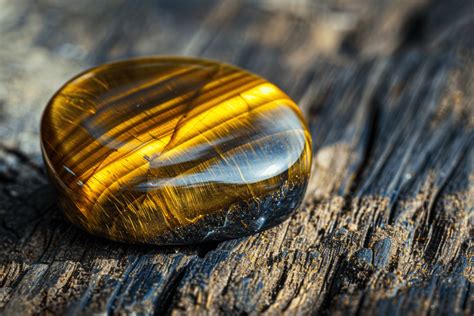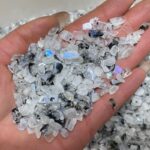Nature never ceases to amaze us. From the towering mountains to the shimmering stars, the world is teeming with wonders that captivate our senses. One such wonder is the enigmatic natural stone that glows in the dark, offering a breathtaking spectacle that transcends the boundaries of ordinary experience.

This extraordinary luminescence, known as phosphorescence or fluorescence, occurs when certain minerals absorb energy from light or other sources and release it slowly over time as visible light. The glow can range from a soft, ethereal radiance to a vibrant luminescence that rivals the moonlit sky.
Types of Glowing Stones
1. Phosphorite
Phosphorite, also known as apatite, is a sedimentary rock composed primarily of calcium phosphate. It is one of the most common sources of phosphate and is often used in the production of fertilizers. Phosphorite can exhibit a strong phosphorescence in shades of green, yellow, or blue.
2. Calcite
Calcite is a carbonate mineral that forms as a result of chemical precipitation from water. It is often found in caves, where it can create stunning formations that glow in the dark. Calcite typically exhibits a bluish or greenish glow.
3. Fluorite
Fluorite is a mineral composed of calcium fluoride. It is known for its wide range of colors, including purple, green, blue, and yellow. Fluorite exhibits fluorescence, meaning that it emits light when exposed to ultraviolet radiation.
4. Gypsum
Gypsum is a sulfate mineral that forms from the evaporation of water. It is commonly used in the construction industry to make drywall and plaster. Gypsum can exhibit a weak phosphorescence in shades of white or green.
Applications of Glowing Stones
The unique properties of glowing stones have inspired a wide range of applications, including:
- Jewelry and Accessories: Glowing stones can be incorporated into jewelry, such as necklaces, bracelets, and earrings, to create enchanting and otherworldly adornments.
- Home Decor: Glowing stones can be used to create decorative items, such as sculptures, lamps, and wall art, that emit a soft and ambient glow.
- Landscaping: Glowing stones can be used to enhance the beauty of gardens and outdoor spaces by creating glowing pathways, borders, and decorative features.
- Aquariums and Terrariums: Glowing stones can add a touch of magic to aquariums and terrariums, providing a unique and captivating spectacle for both humans and aquatic life.
Phosphorescent Lighting
In addition to their decorative and aesthetic applications, glowing stones have also been explored for their potential use in phosphorescent lighting. Phosphorescent materials can absorb energy from sunlight or other sources and release it slowly over time as visible light. This property could revolutionize the lighting industry by creating energy-efficient and sustainable lighting solutions.
According to the International Energy Agency (IEA), artificial lighting accounts for approximately 15% of global electricity consumption. By replacing traditional incandescent bulbs with phosphorescent materials, it is estimated that substantial energy savings could be achieved.
Generating Ideas for New Applications
The glowing properties of natural stone offer endless possibilities for new and innovative applications. To generate ideas, consider the following:
Glowmanship: A term coined to describe the art of creating luminous works of art using glowing stones. Glowmanship could be used to create sculptures, paintings, and installations that illuminate public spaces, museums, and private residences.
GloCharge: A method of harnessing the energy from glowing stones to charge electronic devices. By incorporating glowing stones into portable chargers, it may be possible to power mobile phones, laptops, and other devices without relying on electricity.
GlowPlay: A concept that combines glowing stones with interactive technology to create novel entertainment experiences. GlowPlay could involve interactive games, puzzles, and sensory installations that respond to the glow of the stones.
Effective Strategies
To maximize the effectiveness of glowing stones in your applications, consider the following strategies:
- Choose the Right Stone: Select a stone that exhibits a strong and long-lasting glow. Phosphorite and calcite are excellent choices for phosphorescence, while fluorite is ideal for fluorescence.
- Maximize Exposure to Light: Glowing stones require exposure to light to charge. Ensure they are placed in areas with ample sunlight or artificial illumination.
- Consider the Viewing Conditions: The darkness of the surrounding environment will affect the visibility of the glow. Create conditions where the glow can be fully appreciated.
Common Mistakes to Avoid
- Overexposure to Light: Prolonged exposure to intense light can diminish the glow of the stones. Avoid exposing them to direct sunlight for extended periods.
- Exposure to Moisture: Some glowing stones can be damaged by moisture. Protect them from rain, spills, and high humidity.
- Ignoring the Charging Time: Allow sufficient time for the stones to charge before expecting them to glow. The charging time can vary depending on the type of stone and the intensity of the light source.
Pros and Cons
Pros:
- Enchanting and otherworldly appearance
- Potential for energy-efficient lighting solutions
- Wide range of applications, from home decor to interactive entertainment
Cons:
- Limited charging capacity and need for periodic recharging
- Potential for damage from overexposure to light or moisture
- May not be suitable for all lighting conditions
Conclusion
The natural stone that glows in the dark is a captivating phenomenon that has captivated the human imagination for centuries. Its unique luminescence offers a myriad of possibilities for applications in jewelry, home decor, landscaping, and even energy-efficient lighting. With its enchanting beauty and practical potential, this extraordinary material continues to inspire awe and wonder.




























